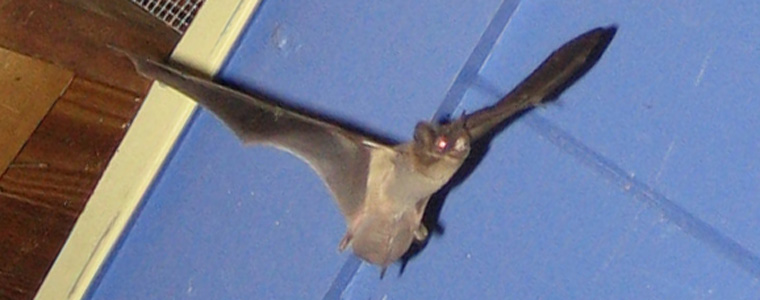-
info@aaanimalcontrol.com
Call us for help in your town
Humane Wildlife Education
In What Ways Do Bats Use Echolocation
Need bat removal in your hometown? We service over 500 USA locations! Click here to hire us in your town and check prices - updated for year 2020.
Nocturnal bats use echolocation to create a mental map of their surroundings in complete darkness. By listening to the echoes of their ultrasonic chirps, they rapidly gather and process all the information they need in order to successfully navigate their environment as they hunt and eat their unsuspecting flying prey.

So, how exactly does bat echolocation work? Bats listen to the chirps produced through their mouth or nose as they bounce off the objects nearby. When the echo of those chirps returns to the bat, the cartilage of the outer ear funnels the sound waves first into the ear canal, then into the eardrum. The eardrum will then produce vibrations which are further transferred into the basilar membrane, which runs the length of the cochlea. The vibrations are then converted by the cochlea into nerve impulses which the brain rapidly interprets.
With amazing throat muscles, the bat is capable of chirping approximately 180 times per second. The abundance of information that it gathers from these high-pitched chirps lets the bat create a perceptual map of its surrounding physical space. Nonetheless, the brain needs help to promptly interpret all this information. To help its brain create a perfect mental replica of its surrounding environment, the bat uses different frequency patterns with its chirps, patterns that make it easy for the brain to separate signal clutter from pertinent information. These varying frequency patterns will bounce off from objects differently depending on the object's shape, size, and distance, each specific pattern producing a different echo intensity in the bat's ear. The brain is able to create a mental representation of the physical area that surrounds the bat by analyzing and interpreting these different echo intensities.
Learn more: Do bats avoid light?
In order to measure how far away a specific object is, a bat will analyze the time delay between when it hears its chirp to when it receives its subsequent echo. For directional information when it hunts, the bat will simply take notice of which ear intercepts the echo first. If the right ear hears the echo first, the insect must be on the bat's right side. The brain then interprets the information in each ear in order to allow the bat to guide itself towards its prey.
If the bat is out hunting, it will first send out low frequency chirps over a wide range. The bat is now looking for low intensity echoes that bounce off small objects such as tiny insects. When it receives this low intensity echo associated with small insects, the bat will now produce a high frequency chirp, directed towards the potential prey. At this point, on top of clearly separating the high intensity echoes from the low intensity ones, the bat can also distinguish between different types of low intensity echoes, being able to go after its prey with surgical precision – or bat precision, some would say.
While the way bats and whales echolocate has been our inspiration for sonar and radar technologies, they are not the only animals that practice this technique. Echolocation is also practiced by some birds, as well as by the shrew mouse. Blind humans have been also known to be
able to use echolocation by producing clicking sounds, and some scientists have witnessed the common lab rat echolocating in order to get out of mazes.
For more information, you may want to click on one of these guides that I wrote:
How much does bat removal cost? - get the lowdown on prices.
How to get rid of bats - my main bat removal info guide.
Example bat removal photographs - get do-it-yourself ideas.
Bat job blog - learn from great examples of bat jobs I've done.


















